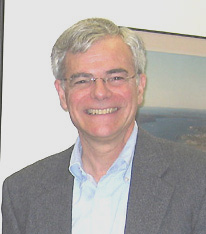
| T H E N I H C A T A L Y S T | M A Y – J U N E 2005 |
|
|
|
| F R O M | T H E | D E P U T Y | D I R E C T O R | F O R | I N T R A M U R A L | R E S E A R C H |
A PITCH FOR INTRAMURAL SUPPORT OF PUBLIC ACCESS
|
Providing
our published literature to our colleagues and the general public free
of charge is responsive to the requests of Congress and most patient constituency
groups and is clearly the right thing to do. So what’s the fuss?
|
 |
| Michael
Gottesman |
Elsewhere in this issue, you will read a detailed account of a town meeting held by Dr. Zerhouni to present to the NIH staff important information about making NIH-sponsored research available to all scientists and to the general public. Earlier, I sent out a general notice to our scientific staff about this policy.
The general idea is that beginning May 2, 2005, NIH intramural authors (and extramural scientists reporting on NIH-funded research) may deposit their manuscripts that have been accepted for publication into the public NLM website called PubMed Central. The authors designate how soon after journal publication their papers will be released on PubMed Central—from immediately to up to 12 months after publication. Submission to PubMed Central is voluntary, and the process has been designed to be easy and quick. The details about how to do this are available at the website.
If you would like help or perhaps a demonstration for your research group, contact the NIH Library at 301-496-2184 or at its website.
Providing our published literature to our colleagues and the general public free of charge is responsive to the requests of Congress and most patient constituency groups and is clearly the right thing to do. So what’s the fuss?
The publishing industry and scientific professional societies have expressed concerns about the effect of this policy on their ability to market peer-reviewed journals, in part due to concerns about copyright. (As intramural scientists, we have no copyright in our work to assign to journals; simply informing the journal that we intend to provide the final manuscript to PubMed Central should satisfy concerns of this type.)
Scientists have worried about the potential appearance of two forms of their work in the public domain (the form submitted to PubMed Central, which is the original accepted version of the manuscript by the journal, and the copyedited journal version); they have also anticipated the possibility that journals will restrict publication by scientists who conform to the NIH policy on public access. With respect to the latter point, many journals have issued policies asking their authors to publicly release their articles within a stated period of time (six months for some, 12 months for others), whereas other journals have so far been silent on this issue.
There is currently no requirement for NIH intramural scientists to submit their articles to PubMed Central. But I am writing to urge you to make note of the public access policy, think hard about the importance of this policy for science and for the NIH, and spend a few minutes submitting your manuscripts to PubMed Central in as timely a way as possible.
Indeed, very early reports suggest that this request will be favorably received: PubMed Central began to receive manuscripts on NIH-supported research shortly after the new policy went into effect. As anticipated, submission time appears to range from six to eight minutes.
In addition to the obvious public benefits of PubMed Central submission, what are the advantages to scientists?
![]() In cases where public access is provided, we expect an immediate increase in
citation rate because access to the publication is not limited to people who
subscribe to the journal or can travel to a library.
In cases where public access is provided, we expect an immediate increase in
citation rate because access to the publication is not limited to people who
subscribe to the journal or can travel to a library.
![]() PubMed Central will format and index all articles so that they are fully text
searchable—this amenity will make it easier for our colleagues and our
own laboratories to find specific information embedded in our published work.
PubMed Central will format and index all articles so that they are fully text
searchable—this amenity will make it easier for our colleagues and our
own laboratories to find specific information embedded in our published work.
![]() Finally, it appears that many of the journals in which we publish our papers
will actually benefit from the wider exposure afforded by PubMed Central. They
will see an increase in their impact factors, which in turn will reflect positively
on our work—a win-win situation.
Finally, it appears that many of the journals in which we publish our papers
will actually benefit from the wider exposure afforded by PubMed Central. They
will see an increase in their impact factors, which in turn will reflect positively
on our work—a win-win situation.
So, do the right thing. Submit your articles that have been accepted for publication to PubMed Central and allow their release in as short a time period after publication as you deem feasible.
—Michael
Gottesman
Deputy
Director for Intramural Research